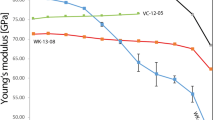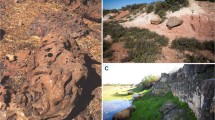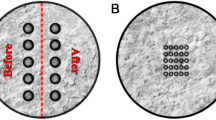Abstract
Before 100,000 years ago, during the Middle Stone Age (MSA) of South Africa, silica varieties of minerals and rocks were sometimes heated during tool making in order to improve their knapping properties. If the heating and cooling process is not controlled, failure results and the nodules fracture. Recently, we postulated that the reversible α- to β-phase transition may play a role in causing silcrete, a type of rock often used to make stone tools in the Western Cape, to fracture. In this new study, we analyse the thermal behaviour (520–620 °C) of silcrete and compare it to that of two chalcedony samples from different origins, together with samples of chert, agate and flint. These minerals and rocks were commonly used to make stone tools. Differential scanning calorimetry (DSC) measurements show that the α- to β-phase transformation is prominent in silcrete, agate and one of the chalcedony samples, weaker in chert and the second chalcedony sample, but non-existent in flint. X-ray fluorescence (XRF), thermogravimetric analysis (TG) and carbon and sulphur analyses show differences in elemental composition between the rocks and minerals. X-ray powder diffraction (XRD), Fourier transform infrared (FTIR) and Raman spectroscopy highlight differences in microstructure. These small differences in chemical composition and structure contribute to a variety of chemical reactions and phase transformations that can take place in rocks and minerals, which in combination determine their stability upon heating and show that care should be taken when generalising thermal behaviour.




Similar content being viewed by others
References
Brown K, Marean CW, Herries AIR, Jacobs Z, Tribolo Z, Braun D, Roberts DL, Meyer MC, Bernatchez J. Fire as an engineering tool of early modern humans. Science. 2009;325:859–62.
Crabtree DE, Butler BR. Notes on experiments in flintknapping 1: heat treatment of silica materials. Tebiwa. 1964;7:1–16.
Purdy BA, Brooks HK. Thermal alteration of silica minerals: an archaeological approach. Science. 1971;173:322–5.
Domanski M, Webb J. Effect of heat treatment on siliceous rocks used in prehistoric lithic technology. J Archaeol Sci. 1992;19:601–14.
Domanski M, Webb J. A review of heat treatment research. Lithic Technol. 2007;32:153–94.
Borradaile GJ, Kissin SA, Stewart JD, Ross WA, Werner T. Magnetic and optical methods for detecting the heat treatment of chert. J Archaeol Sci. 1993;20:57–66.
Schmidt P, Masseb S, Laurent G, Slodczyk A, Le Bourhis E, Perrenoud C. Crystallographic and structural transformations of sedimentary chalcedony in flint upon heat treatment. J Archaeol Sci. 2012;39:135–44.
Collins MB, Fenwick JM. Heat treating of chert: methods of interpretation and their application. Plains Anthropol. 1974;19:134–45.
Schmidt P, Porraz G, Slodczyk A, Bellot-Gurlet L, Archer W, Miller CE. Heat treatment in the South African Middle Stone Age: temperature induced transformations of silcrete and their technological implications. J Archaeol Sci. 2013;40:3519–31.
Beauchamp EK, Purdy BA. Decrease in fracture toughness of chert by heat treatment. J Mater Sci. 1986;21:1963–6.
Purdy BA. Investigations concerning the thermal alteration of silica minerals: an archaeological approach. Tebiwa. 1974;17:37–66.
Olausson DL, Larsson L. Testing for the presence of thermal pretreatment of flint in the Mesolithic and Neolithic of Sweden. J Archaeol Sci. 1982;9:275–85.
Wadley L, Prinsloo LC. Experimental heat treatment of silcrete implies analogical reasoning in the Middle Stone Age. J Human Evol. 2014;70:49–60.
Cairncross B. Field guide to rocks and minerals of Southern Africa. Cape Town: Struik; 2004.
Webb J, Finlayson B, Cochrane G, Doelman T, Domanski M. Silcrete quarries and artefact distribution in the Central Queensland Highlands, Eastern Australia. Archaeol Ocean. 2013;48:130–40.
Smykatz-Kloss W, Klinke W. The high-low quartz inversion—key to the petrogenesis of quartz-bearing rocks. J Therm Anal. 1997;48:19–38.
Loubser M, Verryn S. Combining XRF and XRD analyses and sample preparation to solve mineralogical problems. S Afr J Geol. 2008;111:229–38.
Raman CV, Nedungadi TMK. The alpha beta transformation of quartz. Nature. 1940;145:147.
Rao CNR, Gopalakrishnan J. New directions in solid state chemistry. In: Cambridge solid state science series. Cambridge: Cambridge University Press; 1986. p. 148-155.
Barker C, Robinson SJ. Thermal release of water from natural quartz. Am Miner. 1984;69:1078–81.
Colomban Ph, Slodczyk A. The structural and dynamics neutron study of proton conductors: difficulties and improvement procedures in protonated perovskite. A Eur Phys J Spec Top. 2012. doi:10.1140/epjst/e2012-01670-7.
Kerr R, Wood N. Science and civilisation in China Volume 5: chemistry and chemical technology, Part 12, ceramic technology. Cambridge: Cambridge University Press; 2004. p. 57. ISBN, 0521838339, 9780521838337.
Ríos S, Salje EKH, Redfern SAT. Nanoquartz versus macroquartz: a study of the α–β phase transition. Eur Phys J B. 2001;20:75–83.
Dubrawski JV. The effect of particle size on the determination of quartz by differential scanning calorimetry. Thermochim Acta. 1987;120:257–60.
Blasy M. Variability of α/ß inversion temperatures of natural quartz. Int J Sci Res. 2014;3(10):454–8.
Vettegren VI, Sobolev GA, Kireenkova SM, et al. Effect of water on the α–β phase transitionin a surface quartz layer. Phys Solid State. 2014;56:1228–33. doi:10.1134/S1063783414060377.
Ghiorso MS, Carmichael ISE, Moret LK. Inverted high-temperature quartz. Contrib Miner Pet. 1997;68:307–23.
Kostyrko K, Skoczylas M, Klee A. Certified reference materials for thermal analysis. J Therm Anal. 1988;33:351–7.
Colomban Ph. Proton and protonic species: the hidden face of solid state chemistry. How to measure H-content in materials? Fuel Cells. 2013;13(1):6–18.
Xing Z, Beaucour A, Hebert R, Noumowe A, Ledesert B. Influence of the nature of aggregates on the behaviour of concrete subjected to elevated temperature. Cem Concrete Res. 2011;41(4):392–402.
Razafinjato RN, Beaucour A, Hebert RL, Ledesert B, Bodet R, Noumowe A. High temperature behaviour of a wide petrographic range of siliceous and calcareous aggregates for concretes. Constr Build Mater. 2016;123:261–73.
Tucker ME. Sedimentary petrology: an introduction to the origin of sedimentary rocks. 3rd ed. Oxford: Blackwell Science; 2001.
Adamo I, Ghisoli C, Caucia F. A contribution to the study of FTIR spectra of opals. N Jb Miner Abh. 2010;187(1):63–8.
Gouadec G, Colomban Ph. Raman spectroscopy of nanostructures and nanosized materials. J Raman Spectrosc. 2009;38:598–603.
Froment F, Tournié A, Colomban Ph. Raman identification of natural red to yellow pigments: ochre and iron-containing ores. J Raman Spectrosc. 2008;39:560–8.
Fritsch E, Rossman GR. An update on color in gems. Part 1: introduction and colors caused by dispersed metal ions. Gems and Gemology. 1987;23(3):126–39.
López A, Frost RL. Raman spectroscopy of pyrite in marble from Chillagoe, Queensland. J Raman Spectrosc. 2015;46(10):1033–6.
Wadley L, de la Peña P, Prinsloo LC. Thermal responses of South African agate and chalcedony when heated experimentally, and the global implications for heated archaeological minerals. J. Field Archaeol. 2017 online.
Labus M. Thermal methods implementation in analysis of fine-grained rocks containing organic matter. J Therm Anal Calorim. 2017;15:1–9.
Sitarz M, Wyszomirski P, Handke B, Jelen P. Moganite in selected Polish chert samples: the evidence from MIR, Raman and X-ray studies. Spectrochim Acta Mol Biomol Spectrosc. 2014;122:55–8.
Schmidt P. What causes failure (overheating) during lithic heat treatment? Archaeol Anthropol Sci. 2014;6(2):107–12.
Schmidt P, Badou A, Fröhlich F. Detailed FT near-infrared study of the behavior of water and hydroxyl in sedimentary length-fast chalcedony, SiO2, upon heat treatment. Spectrochim Acta Part A. 2011;81:552–9.
Zhang LH, Gong H, Wang JP. Thermal decomposition kinetics of amorphous carbon nitride and carbon films. J Phys Condens Matter. 2002;14:1697–708.
Damby DE, Llewellin EW, Horwell CJ, Williamson BJ, Najorka J, Cresseye G, Carpenter M. The α–β phase transition in volcanic cristobalite. J Appl Cryst. 2014;47:1205–15.
Mercieca A. Burnt and broken: an experimental study of heat fracturing in silcrete. Aust Archaeol. 2000;51:40–7.
Acknowledgements
The authors would like to thank Dr. Wiebke Grote and Dr. Jeanette Dykstra from the XRD & XRF Facility, Department of Geology, University of Pretoria, for the XRD and XRF measurements, respectively. We thank Paloma de la Peña for providing the flint sample and G. L. Prinsloo for the digital images of the samples. All the authors acknowledge the National Research Foundation (NRF) for financial support. Opinions expressed in the paper are not necessarily those of the NRF. We thank two anonymous reviewers for useful comments that improved this paper.
Author information
Authors and Affiliations
Corresponding author
Electronic supplementary material
Below is the link to the electronic supplementary material.
Rights and permissions
About this article
Cite this article
Prinsloo, L.C., van der Merwe, E.M. & Wadley, L. The thermal behaviour of silica varieties used for tool making in the Stone Age. J Therm Anal Calorim 131, 1135–1145 (2018). https://doi.org/10.1007/s10973-017-6602-z
Received:
Accepted:
Published:
Issue Date:
DOI: https://doi.org/10.1007/s10973-017-6602-z




